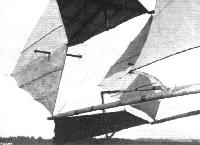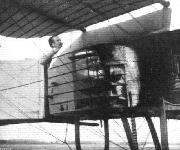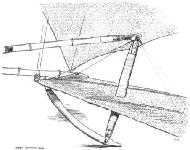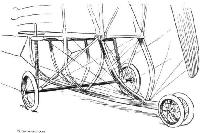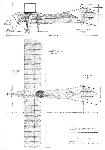P.Lewis British Aircraft 1809-1914 (Putnam)
Cody Monoplane
In his entry No. 30 for the 1912 Military Trials, S. F. Cody forsook the biplane for a new monoplane design in which comfort and streamlining were given greater consideration than hitherto in his aeroplanes. The crew of two were seated side-by-side at the trailing-edge of the wings, with which their heads were on the same level. Their view was enhanced further by the fitting of transparent windows in the fuselage on each side of the cockpit, and their seats consisted of Cody's favourite agricultural implement type.
The main forward section of the fuselage provided an anchorage for the low-set 120 h.p. Austro-Daimler engine which drove the two-bladed 11 ft. 6 ins. diameter Chauviere propeller by a chain. Four bamboo pole extensions to the rear were employed to carry the tail unit and were faired with fabric. The tail surfaces comprised a pair of superimposed, interconnected elevators which were operated by a long bamboo control-rod to the lower surface. Twin rudders were cable-connected to the control-column, which was placed centrally between the seats for use by either occupant and also acted as the combined control for the wing warping, elevators and rudders. The cabane over the upper decking consisted of inverted vee struts at the front and a single vertical post at the rear. The tricycle landing-gear combined heavy coil springs with curved hickory struts for additional shock-absorbing.
The Cody Monoplane was destined never to compete in the famous Military Trials for, in July, 1912, it crashed and was wrecked when it collided with a cow while making a landing on Laffan's Plain.
SPECIFICATION
Description: Two-seat tractor monoplane. Wooden structure, fabric covered.
Manufacturer: S. F. Cody, Laffan's Plain, Farnborough, Hants.
Power Plant: 120 h.p. Austro-Daimler.
Dimensions: Span, 43 ft. 6 ins. Length, 37 ft. Height, 12 ft. 6 ins. Wing area, 260 sq. ft.
Weights: Empty, 2,400 lb. Loaded, 3,100 lb.
Performance: Maximum speed, 83 m.p.h. Cruising speed, 70 m.p.h.
Показать полностью
M.Goodall, A.Tagg British Aircraft before the Great War (Schiffer)
Deleted by request of (c)Schiffer Publishing
CODY monoplane No.IV
Cody began testing this new machine, intended for entry in the Military Trials, in the middle of June 1912. Its life was brief, however, for on 8 July he was forced to land after the engine failed and in the resulting collision with a cow, the machine was damaged beyond repair.
The aircraft was a shoulder-wing monoplane which rested on a two wheel undercarriage with sprung struts and curved hickory wood struts supporting a central skid with twin front wheels. The skid was extended aft to form a tail support. The front fuselage comprising the engine bay and the side-by-side seating was a spruce structure with cabane for the anchorage of wing bracing wires. The fuselage aft of the cockpit was an unconventional structure of four bamboo longerons, faired with fabric covering tapered to a point. The longerons as they extended aft were splayed out to provide mountings for a fixed cruciform tail, plus pivot points for twin rudders and elevators.
The engine drove, by chain, the propeller mounted above on a shaft at two thirds engine speed. The radiator was mounted in front of the engine, but behind the chain drive. The exhaust was fitted with a silencer, which doubled as a heater and emerged from the top of the starboard fuselage side. Fuel and oil tanks were housed in the decking in front of the cockpit, which had transparent sides. Although the engine was exposed it is probable that cowlings were to be added later.
Lateral control was by wing warping, all control movements being made from a central control column between the two occupants. The elevators were operated by a bamboo rod by fore and aft movement and the rudders by cable by a wheel on the column.
Power: 120hp Austro-Daimler six-cylinder, inline, water-cooled driving by Brampton chain a 10ft 2in diameter Chauviere propeller at two thirds engine speed.
Data
Span 43ft 6in *44ft
Chord 6ft 9in
Area 260 sq ft
Elevator area 46 sq ft
Rudder area 46 sq ft
Length 37ft *41ft
Height 12ft 6in * 13ft
Weight 2,400 lb
Weight allup 3,100lb
Speed range 58-83 mph
*from other sources
Показать полностью
Jane's All The World Aircraft 1913
CODY. Cody flying school, Farnborough. Cody commenced experiments with kites in very early days on behalf of the British Admiralty. Subsequently built the first British Army dirigible, and an experimental Army aeroplane. In 1909, his direct connection with the Army ceased. A Cody I was built in 1908. A Cody II was completed June 1910. The special features of both were: very strong construction, great size (II had area of 857 sq feet), ailerons. Later types, except that warping is substituted for ailerons, do not differ very materially except in minor details. All wood construction.
1911. 1913. Model.
4-seater 4-seater May, 1912.
biplane. biplane. Monoplane.
Length............feet(m.) 38 (11.60) 38 (11.60) 38 (11.60)
Span..............feet(m.) 43 (13) 43 (13) 43? (13.25)
Area..........sq.feet(m?.) 484 (44.75) 483 (44.97) 260 (19)
Weight, total...lbs.(kgs.) 1900 (862) 1900 (862) 2400 (1088)
Weight,useful...lbs.(kgs.) 1000 (453) 1000 (453) 7O0
Motor................... 60 Green, 120 Aust. 120 Aust.
later a Daimler Daimler
100 Green
Speed, max......m.p.h.(km.) 70 (115) 75 (120) 83 (135)
min......m.p.h.(km.) 47 (75) 47 (75) 58 (95)
Number built to
end of last year......... 1 1 1
Remarks.--The 1911 is the famous Cody, which, as a 60 h.p., won both Michelin 1911 prizes, and completed the Daily Mail circuit. As a 100 h.p. it won the 1912 Michelin cross-country. By the end of 1912 it is said to have flown a total of 7000 miles. The 1913 is practically a duplicate with a more powerful engine. Special features of the biplanes, maximum camber to lower plane. Both planes equal span. Very strong landing gear. Propeller chain driven: 1-3/4 to 1 gearing. In February, 1913, four biplanes were ordered for the British Army.
Cody lists a mono. for 1913 a trifle longer than the above; also five variations on the biplane of from 35 to 160 h.p., which can be built if required.
Показать полностью
Журнал Flight
Flight, June 29, 1912.
THE CODY MONOPLANE.
IT will come as no surprise to our readers that that skilful designer and intrepid pilot Mr. S. F. Cody, has built a monoplane, as his work in this direction was announced recently in these pages. Now that the new machine has been tested in "occasional jumps," in the words of Mr. Cody himself, there is no need any longer to withhold information concerning it from the public ken, and so by the aid of the accompanying photographs and brief description, we proceed to place before readers of FLIGHT the main essentials of this very interesting piece of work.
A description of the new machine is easier said than done, for there is none other like it to which it may readily be compared. Mr. Cody has always been original, and he remains original even in this, the most stereotyped, perhaps, of all types of flying machines. And this designer's originality is the originality of the inventor rather than of the mere improver. It is a fact that he had never even seen an aeroplane before he had built and flown the first great biplane that was associated with his name. For all the evidence that exists in the new flyer now under consideration, he might never have seen a monoplane either. In so far as the new machine gives evidence of influence in its design, the influence is that of his experience with biplane construction; the wings are similar to the biplane type, so, too, is the undercarriage - of course. The body is altogether new and consists of two distinct sections, the forward part accommodating the engine and pilot, while the after portion consists of bamboo booms with surfacing material stretched between them to form dihedral planes, thus making this after portion look very much like the tail of a paper dart. At its extremities are the tail members proper.
Certain characteristic features worthy of special note include the relative positions of the engine, pilot and wings, the engine is low and the wings are high, the pilot sits behind the engine and has an outlook under the trailing edges of the wings. Coupled with the strong and massive undercarriage there is sufficient evidence of a low centre of gravity. The propeller shaft on the other hand is placed higher up and is driven by a vertical chain.
The machine has an overall length of 37 ft., a span of 46 ft. 6 in. and an overall height of 12 ft. 6 in. that can be reduced to 8 ft. 6 in. in a few minutes for transport by folding down the cabane. Similarly, by dismantling the tail the overall length is reduced to 31 ft. These transport facilities have been influenced by the War Office Competition rules, in which event we hope to see the Cody monoplane figure prominently. The engine is a 120-h.p. Austro-Daimler motor and the transmission chain a Brampton. The propeller is a British-built Chauviere, 11 ft. 6 in. in diameter and pitch. In construction, it has 10 laminations of walnut.
It runs at two-thirds engine speed, for there are 24 sprockets on the crankshaft wheel and 16 on the propeller wheel. The static thrust from this combination Mr. Cody estimates to be something in the neighbourhood of 800 lbs. Aft of the engine is the cockpit for the accommodation of the pilot and passenger. They are seated side by side and the control is arranged in the central position so that both may be able to handle it with equal facility. As regards this, the Cody control is especially convenient for all three controlling movements of the rudder, the elevator, and the warping are operated from the one column. A movement of the column to and from the operator actuates the twin elevators by means of a long bamboo connecting rod. Warping is done by swinging the column from side to side. To steer, the handwheel is rotated. The type of seat that Cody provides for the pilot and passenger are fully recognised as Cody seats. Otherwise, the same style of thing is used very frequently on agricultural machinery. Nevertheless, for comfort they leave nothing to be desired.
Those aboard the machine are protected from the rush of air by a bulkhead that separates the motor from the cockpit. The magnetos - there are two - however, protrude through this bulkhead, as also does the rear end of the crank-shaft. To this a chain-wheel is keyed for it was intended to fit a starting handle so that the engine could be set in motion by the pilot without any need of him having to leave his seat. But Bosch dual ignition, Mr. Cody finds, answers its purpose quite well, so the extra weight of a cranking device has been saved.
On either side of the cockpit transparent windows of non-inflammable celluloid give the pilot a clear view of what is going on beneath him.
A type of bonnet extends back from the propeller to a point just in front of the pilot. Under this bonnet are arranged the fuel tanks. Those at present fitted are of small capacity, just sufficient for testing purposes, but a petrol tank holding something like 68 gallons and an oil tank to correspond are being put through. These will replace the existing reservoirs when the preliminary trials are finished.
Below these is the silencer, also fitted inside the cockpit. It exhausts through a large diameter pipe on the right-hand side.
The landing gear will be quite familiar to those who have studied Cody's previous machines. The only innovation is that the four pairs of hickory struts supporting the body from the central skid are curved. By curving them in this fashion a great deal of springiness is introduced between the skid and the body, and should the landing wheels spring up far enough for the skid to come very forcibly into contact with the ground, there would be far less likelihood of damage resulting than if straight struts were used.
Regarding the wings, the same type of construction is employed as is used in the planes of the Cody biplane. Each is stayed from above by six 12-gauge wires and from below by twelve stays, each composed of a pair of 12-gauge wires.
Quite a feature of the machine is the ease and surety with which it may be "taxied" about. Mr. Cody gave us a demonstration of this, and turned figures of eight on the ground in surprisingly little space.
From the tests that have already taken place, the machine has shown itself to have exceptional powers at climbing. Its speed is not certainly known at present, but somewhere very near and possibly more than seventy miles per hour is about the figure. The weight is 1,400 lbs. without passengers or fuel.
Показать полностью








